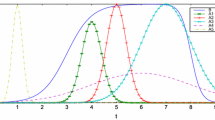Abstract
Data mining is most commonly used in attempts to induce association rules from databases which can help decision-makers easily analyze the data and make good decisions regarding the domains concerned. Different studies have proposed methods for mining association rules from databases with crisp values. However, the data in many real-world applications have a certain degree of imprecision. In this paper we address this problem, and propose a new data-mining algorithm for extracting interesting knowledge from databases with imprecise data. The proposed algorithm integrates imprecise data concepts and the fuzzy apriori mining algorithm to find interesting fuzzy association rules in given databases. Experiments for diagnosing dyslexia in early childhood were made to verify the performance of the proposed algorithm.








Similar content being viewed by others
References
Agrawal R, Imielinski T, Swami A (1993) Mining association rules between sets of items in large databases. In: SIGMOD, Washington, D.C., USA, pp 207–216
Agrawal R, Srikant R (1994) Fast algorithms for mining association rules. In: International conference on very large data bases, Santiago de Chile, pp 487–499
Ajuriaguerra J (1976) Manual de psiquiatría infantil. Barcelona, Toray-Masson
Alatas B, Akin E (2006) An efficient genetic algorithm for automated mining of both positive and negative quantitative association rules. Soft Comput Fusion Found Methodol Appl 10(3):230–237
Alcala-Fdez J, Fernandez A, Luego J, Derrac J, Garcia S, Sanchez L, Herrera F (2011) Keel data-mining software tool: data set repository, integration of algorithms and experimental analysis framework. J Multiple-Valued Log Soft Comput 17(2–3):255–287
Alcala-Fdez J, Flugy-Pape N, Bonarini A, Herrera F (2010) Analysis of the effectiveness of the genetic algorithms based on extraction of association rules. Fundamenta Informaticae 98(1):1–14
Baudrit C, Dubois D, Perror N (2008) Representing parametric probabilistic models tainted with imprecision. Fuzzy Sets Syst 15(1):1913–1928
Bertoluzza C, Gil M, Ralescu D (2003) Statistical modeling. Analysis and management of fuzzy data. Springer, Berlin
Chen C, Hong T, Tseng V (2011) Genetic-fuzzy mining with multiple minimum supports based on fuzzy clustering. Soft Comput Fusion Found Methodol Appl. doi:10.1007/s00500-010-0664-1
Couso I, Sanchez L (2008) Higher order models for fuzzy random variables. Fuzzy Sets Syst 159:237–258
Delgado M, Marín N, Sánchez D, Vila M (2003) Fuzzy association rules: general model and applications. IEEE Trans Fuzzy Syst 11(2):214–225
Dubois D, Hullermeier E, Prade H (2006) A systematic approach to the assessment of fuzzy association rules. Data Min Knowl Disc 13(2):167–192
Dubois D, Prade H (1992) When upper probabilities are possibility measures. Fuzzy Sets Syst 49:65–74
Dubois D, Prade H, Sudamp T (2005) On the representation, measurement, and discovery of fuzzy associations. IEEE Trans Fuzzy Syst 13(2):250–262
Han J, Kamber M (2006) Data mining: concepts and techniques, 2nd edn. Morgan Kaufmann, San Fransisco
Han J, Pei J, Yin Y (2004) Mining frequent patterns without candidate generation: a frequent-pattern tree approach. Data Min Knowl Dis 8(1):53–87
Hong T, Kuo C, Chi S (1999) Mining association rules from quantitative data. Intell Data Anal 3(5):363–376
Hong T, Kuo C, Chi S (2001) Trade-off between time complexity and number of rules for fuzzy mining from quantitative data. Int J Uncertain Fuzziness Knowl Based Syst 9(5):587–604
Hong T, Lee Y (2008) An overview of mining fuzzy association rules. In: Bustince H, Herrera F, Montero J (eds) Studies in fuzziness and soft computing, vol 220. Springer, Berlin, pp 397–410
Hullermeier E, Yi Y (2007) In defense of fuzzy association analysis. IEEE Trans Syst Man Cybern Part B Cybern 37(4):1039–1043
Kaufmann A, Gupta M (1991) Introduction to fuzzy arithmetic: theory and applications. Van Nostrand Reinhold, New York
Kaya M (2006) Multi-objective genetic algorithm based approaches for mining optimized fuzzy association rules. Soft Comput Fusion Found Methodol Appl 10(7):578–586
Limbourg P (2005) Multi-objective optimization of problems with epistemic uncertainty. In Proceedings of EMO, pp 413–427
Mladenic D, Lavrac N, Bohanec M, Moyle S (2002) Data mining and decision support: integration and collaboration. Kluwer, Norwell
Palacios A, Sanchez L, Couso I (2011) Future performance modelling in athletism with low quality data-based GFSs. J Multiple-Valued Log Soft Comput 17(2–3):207–228
Ruspini E (1969) A new approach to clustering. Inf Control 15:22–32
Sanchez L, Couso I, Casillas J (2007) Modelling vague data with genetic fuzzy systems under a combination of crisp and imprecise criteria. In: IEEE symposium on computational intelligence inmulticriteria decision making, pp 30–37
Sanchez L, Couso I, Casillas J (2009) Genetic learning of fuzzy rules on low quality data. Fuzzy Sets Syst 160(17):2524–2552
Sanchez L, Suarez M, Villar J, Couso I (2008) Mutual information-based feature selection and partition design in fuzzy rule-based classifiers from vague data. Int J Approx Reason 49:607–622
Sudkamp T (2005) Examples, counterexamples, and measuring fuzzy associations. Fuzzy Sets Syst 149(1):57–71
Sun K, Fengshan B (2008) Mining weighted association rules without preassigned weights. IEEE Trans Knowl Data Eng 20(4):489–495
Thomson P, Gilchrist P (1996) Dyslexia: a multidisciplinary approach. Chapman and Hall, London
Toro J, Cervera M (1980) TALE Test de Análisis de la lectoescritura. Pablo del Río, Madrid
Villar J, Otero A, Otero J, Sanchez L (2009) Taximeter verification using imprecise data from gps and multiobjective algorithms. Eng Appl Artif Intell 22:250–260
Vinuessa M, Coll J (1984) Tratado de atletismo. Servicio Geográfico del Ejército
Wu B, Sun C (2001) Interval-valued statistics, fuzzy logic, and their use in computational semantics. J Intell Fuzzy Syst 1–2(11):1–7
Zhang C, Zhang S (2002) Association rule mining: models and algorithms. Springer, Berlin
Acknowledgments
This study was supported by the Spanish Ministry of Education and Science under Grants no. TIN2008-06681-C06-{01 and 04}, TIN2011-28488 and by the Principado de Asturias under Grant PCTI 2006–2009.
Author information
Authors and Affiliations
Corresponding author
Rights and permissions
About this article
Cite this article
Palacios, A.M., Gacto, M.J. & Alcalá-Fdez, J. Mining fuzzy association rules from low-quality data. Soft Comput 16, 883–901 (2012). https://doi.org/10.1007/s00500-011-0775-3
Published:
Issue Date:
DOI: https://doi.org/10.1007/s00500-011-0775-3




